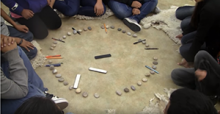Article
A game traditionally played by Navajo women before sunset. The Navajo name for this game is tsìdìł. Navajo legend suggests that Changing Woman gave the game to the first Dine' clans to teach a lesson about ethics, morality, and living in harmony.
Players create a circle of forty rocks with a large flat stone in the center. The players then throw wooden sticks into the circle, scoring the game by where the sticks fall relative to the center stone and by which side of the stick was up when it fell. The game is curtailed at nightfall, limiting the duration of the play. In addition to teaching moderation, by stopping the play of the game at nightfall, the game also represents movement through the circle of life: the circle of stones represents the Navajo homeland, Dinetah; the stones that make up the circle are the stars found in Father Sky; the center stone represents Mother Earth; three sticks painted white on one side and black on the other, represent day and night. The four spaces between the stones represent the Colorado, Rio Grande, Little Colorado and San Juan rivers.
Today, the game is used in classrooms to teach history, culture, and the Navajo language.
"Navajo Stick Game, Fall 2014 Semester," by Jonah Begay, Interdisciplinary Film and Digital Media Program, University of New Mexico, Albuquerque (Independent Project). YouTube, https://youtu.be/UdJ8vG-Rl3A, accessed May 19, 2016.
Manuscripts
References
Begay, Jonah
2014 Navajo Stick Throwing Game. Independent Project, Interdisciplinary Film and Digital
Media Program, University of New Mexico. (Independent Project).
https://youtu.be/UdJ8vG-Rl3A, accessed May 19, 2016.
Dolfin, John
1921 Bringing the Gospel in Hogan and Pueblo. Grand Rapids: Van Noord.
Frisbie, Charlotte Johnson
1982 Traditional Navajo Women: Ethnographic and Life History Portrayals. American
Indian Quarterly 6 (s 1 & 2): 11–33.
Haile, Berard
1933 Navaho Games of Chance and Taboo. Primitive Man: Quarterly Bulletin of the
Catholic Anthropological Conference. Washington, D.C.: The Conference.

